"The
taste and talent of this
people can be seen through
the designs of their earthen
wares", R.
Ghirshman
The history of the art of
pottery in Iran goes back
into ancient time. When
agriculture came into
existence and cultivation
started on Iran's plateau by
me primitive races of this
land, people made utensils
of killed clay in order to
meet their needs.
Fingerprints of primitive
natives of Iran can be seen
on these earthenware. The
first earthenware were two
kinds, black utensils and
red ones, both of these had
very simple construction.
Gradually, simple
earthenware, were being deco
rated by geometric designs.
Studying these designs shows
us that Iranians were very
skillful in making designed
earthenware and represented
these designs in a very
lively and beautiful manner.
Iran could be called the
main birth place of designed
earthenware utensils.
Designing earthenware in
Iran started about 4
thousand years BC
The earthenware belonging
to four thousand year BC had
been killed more carefully
in newly made kilns. The
shapes and forms of these
earthens show that,
invention of the pottery
rotating machine must have
been done in that time.
The artists by using this
new machine made different
kinds of utensils like:
piped pots, bowls and jars
for storage of corns and
grains.
Among excavated earthens
belonging to this age, some
primitive earthen statues in
the form of animals and
birds were found which were
used more ornamentally
rather than anything else.
During the past hundred
years, many valuable
remnants earthenware from
different civilizations have
been found in "Sialk" "Tape
Misar", "Shush" "Tepe Gyan"
'Tape Hasanlu" and 'TalBacon"
in Takhte-Jamshid. Studying
these works will reveal the
changing process of art of
pottery in Iran. Images of
horns of cows and reindeers,
wings of birds and shouts of
lions are some kind of
decorative design of pottery
in fourth Thousand Year BC
The strength and durability
of this art caused its glory
and spread all over Iran's
plateau and even beyond
there.
At the end of third
century and in second
century BC pottery became a
little delicate and some
times decorated by engraved
designs. The earthen statue
of a wild goat excavated in
"Kalar Dasht" at the foot of
"Alborz" mountain is a
sample of the art of pottery
of this age.
|
One of the oldest
known dwelling
places of Mian on
the plain is "Sialk
Hill" in south of
Kashan. The board of
archaeologists of "Louvre
Museum" have found
many earthen
utensils through the
excavation of this
hill. In the
earthens, found in
Sialk, there
are,snakes, wild
goats and horses as
|
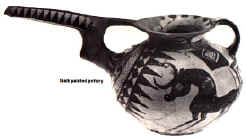
Sialk painted
pottery |
well as geometric designs
on these earthenware.
The sun and horse are the
symbol of Indo-European
tribes. The other designs
found on Sialk's earthens
are simple lines curved
lines, intersecting lines,
plants and flowers and
simple geometric designs.
The earthen works of Sialk
belong to 10th up to 9th
century BC
More earthenware than any
other thing were found in
Sialk graves and these made
a lot of information
accessible. Everything in
these earthens, the strength
of their paste, kilning
temperature, enameled color
surface, designs and styles
which have symbolic values
are novel, each sign
symbolized a man, some of
these earthens were used in
shrouding and burial
ceremonies. There are images
of a hunter, warrior and a
roaring lion, painting on
two pieces of engraved
earthenware belonged to
Sialk. In addition to these
some "Plytons" were found in
the form of animals and
specially birds, among the
earthen utensils of Sialk.
In "Khuzestan Plain" in
Shush, French archaeologists
excavated more than 83 hills
belonging to prehistory
during the years 190 up to
1946, and found varieties of
earthen works. D. Macconn
the chief of the board of
excavation in Shush studied
these works in the art of
pottery point of view.
Among the explored
earthenware in Shush there
are gray earthenware,
designed by images of birds,
sea beasts, wild goats
humped cows and geometric
images. The dwellers in
Shush inspired their designs
through nature. The artists
engraved their supposed
designs on earthenware, then
colored the trenches red and
white. Earthenware of Shush
are very valuable
artistically and are
elegant. They are made of
fine clay.
Dr. E. Smith famous
archaeologist discovered
valuable earthen objects in
two years of excavations
done in Tepe Hisar" of "Damghan".
They belong to the beginning
of four and second centuries
BC.
The earthenware
discovered at the lower part
of the hill were made of red
clay, all hand made but the
earthens which belonged to
the beginning of the second
thousand year BC were made
by using the pottery
rotating machine, these
earthens are brown and buff
in color, different kinds of
decanters, vases and
chalices provided with a
stand in these excavations
were found, which have an
importance in prehistoric
art of pottery of Iran. The
designs on these utensils
are in two forms,
superficial and engraved.
Perfect earthen utensils
belonging to the first
thousand year BC made by "Hasanlu"
civilization in Azarbaijan
were also found. These
earthens are the works of
artists of "Mannai" tribes.
Earthen piped containers are
the most interesting
containers of this
prehistoric region. Potter
artists made the handle of
these containers in
different forms like the
head of a ram, goat or
foxes, some earthen tripods
in Hasanlu graves were found
which have been used for
putting pots on them. Some
of the earthen tripods are
engraved. "Hasanlu" earthens
are gray, red and yellow in
color. These earthens were
used in shrouding and burial
ceremonies of the dead. The
human or animal who was
buried in that ceremony, was
represented as a statue or
an engraved earthenware. "Hasanlu's"
earthenware completely look
like "Khoorvin" earthenware.
"Khoorvin" was the
capital of Mad, it was
located 80 kilometers west
of present Tehran on the
slope of "Alborz" the
remnants of Khoorvin were
found accidentally through a
number of graves "Khoorvin"
tribes buried earthenware
accompanied with the dead.
The earthen containers of
this region have a long pipe
which were used for burial
ceremonies.
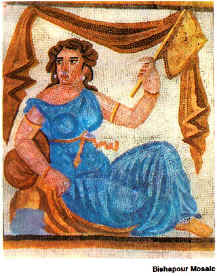
Bishapoor Mosaic
They were black, gray and
red in color. Khoorvin's
potters have made earthen
statues without any
ornaments and, simple (in h
and 8th century BC), just
like old traditions of
ancient dwellers of plateau
of Iran.
The art of pottery in 'Amlash"
a mountainous region in
south west of Caspian Sea
belongs to 9th and 8th
century BC The art of Amlash
has a special characteristic
which symbolizes its high
value. Potters of Am lash
show a beautiful initiative,
so that the Man of the
Twentieth Century is
impressed by these
masterpieces belonging to
three thousand years ago.
Potters were also sculptors.
Their initiative and
creation is wonderful. The
earthens belonging to "Amlash"
have not any designs on them
the artists were very eager
to make utensils in the form
of animals.
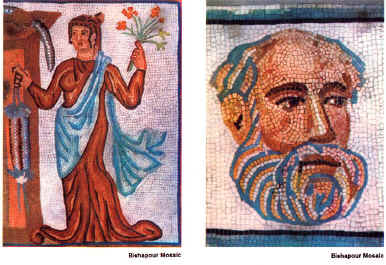
Bishapoor Mosaic
From some regions like "Kurdestan"
"Lorestan" and "Takhte-Jamshid"
valuable earthenware were
found, which symbolized the
high skill of ancient
potters in Iran. There were
interesting earthen utensils
found in "Tepe Giyan" in
Nahavand which were created
extremely elegantly and
tastefully, on these
containers one can see
images of human, storks,
ducks, herons and goat.
There are other simple
images on earthens of "Giyan".
These utensils belong to 1
and 11th century (BC).
Earthen rhytons in Iran,
some of which are considered
to be masterpieces of art of
pottery were observed by
archaeologists and art
specialists.
One of these earthen
rhytons was found in suburb
of "Makoo" in north west of
Iran (Azarbaijan) which is
in the form of a horse head.
There is another rhyton
found in Shush (south of
Iran).
The elegance, beauty and
art of these two rhytons
show that the potters of
plateau of Iran in north and
south, were salient artists.
Some earthen enameled
rhytons with colored
ornaments belonging to "Ziwiye"
region are kept in Iran
Bastan Museum.
Regarding the numerous
rhytons it seems these
valuable utensils have been
produced in a big workshop.
This collection of earthens
have a considerable artistic
value because of their
construction and artistic
painting, they are found
among the explored objects
of Ziwiye, in the excavation
of the grave of an "Ashkani's
Prince". It was usual to use
rhytons in the form of the
head of an animal, for
drinking water during the
eighth and seventh century.
During the Hakhamaneshian
era (550-330 BC) the first
empire of Iran, the art of
pottery started its
evolution, using enamel on
the earthenware have been
created by the artists of
this era. The art of ceramic
which is a part of the art
of pottery started in Iran
in this age. Regardless of
ceramic objects belonging to
ancient Egyptians, the
oldest ceramic utensils are
explored in Iran. These
objects are kept as
prehistoric ceramic utensils
in "Iran Bastan" Museum and
other important museums of
the world. Most of the
ceramic objects belonging to
Hakhamaneshian era are
painted and made perfectly
artistic from the form and
design point of view. We
have inherited valuable
works of Hakhamaneshian
ceramic
| The
primitive kilns for
drying earthenware
in Iran, one of the
oldest of which is
found in Shush,
belonging to seventh
century (BC), were
considerably
improved in
Hakhamaneshian era.
Partian (91-312 BC)
were the followers
of the art of
pottery of
Hakhamaneshian.
Enameling which had
mainly been used in
order to make
ceramic during
Hakhamaneshian, was
used for earthen
utensils in this
era, somescholars
believed Chinese
Acquired enameling
of earthenware from
Partians artists. |
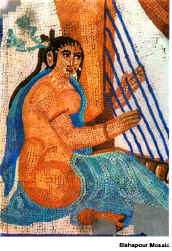
Bishapoor
Mosaic |
Enameled earthenware in
green color were found in
China, belonging to "Hann"
dynasty (206-220 BC). These
earthenware are much like
Partian's earthenware. It
seems that, this skill has
been transmitted to China in
Partian era. Partian
ceramics consisted of usual
tumblers, kinds Of rhytons,
flasks, ewers and earthened
casks covered by a light
blue, green or gray enamel.
They have also made coffins
of enameled kilned earthen
Sassanian ceramics (224-642
A.D.) are very similar to
Persian ceramics, some of
the Sassanian's enameled
earthenware are found in
green or light blue with
engraved designs.
Other samples of
earthenware of this age are
found unenamelled. But they
have made embossed designs
on them by using seals and
mold.
One of the distinguished
characteristics of ceramics
of Iran is its variety and
spread all over the country.
Potter artists followed
their special artistic
method where ever they lived
"Vandenberghe" believes the
reason for creation of
variety in styles and shapes
in earthenware of Iran, is
her ecological condition.
"Unlike Beynolnahrein
ceramics in different
shapes, have been found, and
this differentiation between
these two countries are
caused by geographical
conditions of these lands.
How ever making of
earthenware enameled
utensils were popular in
Iran during Partains and
Sassanian era, but after
appearance of Islam in Iran,
the art of pottery was
developed. The most
successful achievement of
the artists of Islamic era
was the use of nice and
different color in painting
the earthen-wares when
enameling them.
Different earthen
utensils of this age (7th
century A.D.) in different
colors and enamels were
created by the artists in "Rey",
"Shush" "Estakhr" and "Gorgan"
these utensils are the most
supreme products of Islamic
era. Images of animals,
birds and plants decorated
the earthenware of this age.
Earthenware were made by
yellow clay, and Persian
Muslim artists attained
maturity in enameling and
painting on earthenware.
Islamic potters decorated in
three ways, engraving
designs on the earthens,
producing images by using
molds, and creating embossed
designs on their works.
The most beautiful
ceramics in Islamic era have
designs created by mold. The
molds were made of hard
metal or earthens. In this
way they decorated inner and
outer surfaces of
earthenware with designs
about animals, human, plants
and flowers.
In
ninth and eighth
century (BC) the art
of pottery enjoyed
new changes and
important centers of
pottery came into
existence in north
and north east of
Iran.
n the beginning of
Islamic era
(651-1000 A.D.) some
unenamelled colored
earthenware were
found. |
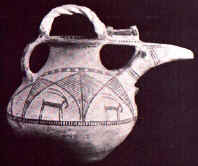
Sialk
painted pottery |
An interesting sample of
these is kept in "Iran
Bastan" Museum. On this
sample geometrical designs
in lozenge form are engraved
and the grooves are painted
in red, yellow, and dark
brown. The earthenware made
in Neyshaboor which belong
to the same age are also
decorated in the same form
and color. Engraving designs
on earthen-wares is a kind
of decoration which has
always been used by Iranian
artist potters. This kind of
decoration was at first some
un-arranged and simple lines
that gradually improved to
the design of images of
human, animals, plants and
flowers.
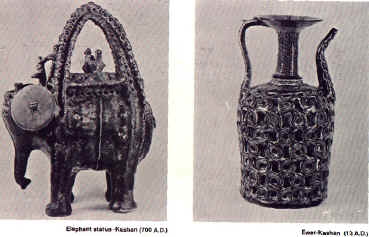
Elephant statue-
Kashan (700 A.D.) Ewer-
Kashan (13 A.D.)
Using calligraphy in
order to decorate
earthen-wares is one of the
ways that Islamic artists
used widespreadly. The
artists used "Koofi's"
script to decorate the
earthenware. This script was
used in two forms, simple
and ornamental.
In studies on early
Islamic ages the Saljooghi's
era (1000-1157 AD) was found
to be one of the most
glorious improvement and
development ages of the art
of pottery in Iran.
Earthenware of this age,
are the most beautiful
samples of pottery in Iran
from the point of view of
color and ornamentation.
Saljooghi's potters helped
make golden colored
earthenware attain
perfection.
In the last part of
Saljooghi's era the art and
industry of pottery reached
its peak improvement point.
They used new methods in
designing and creating
earthenware. The most
important of them was
creation of golden ceramic
with paintings on them. In
addition to that, is the
connection of centers of
pottery in Iran, with the
centers in other countries.
The potters of Iran used
a kind of clay which had
been brought in, from China.
This kind of clay was used
in golden colored ceramic,
having "Koofi's" calligraphy
on the rims and bodies of
utensils in order to
decorate them.' Simple
ceramic enameled utensils in
black, turquoise color, and
light blue color were also
found. Some of the enameled
utensils belonging to "Kashan"
and "Rey" were decorated
using seven colors.'
Invention of painting with
different colors on the
white, blue and turquoise
enameled earthenware is
supposed to be indebted to
the skills of Persian
potters in twelfth century
A.D. Some samples of these
ceramics are kept in
"Metropolitan" Museum.
One of the masterpieces
of its kind which is kept in
the mentioned museum,
belongs to thirteenth
century, a, blue pitcher
with very unique fabric and
ornamentation. Some of the
methods n pottery such as
molding, reticulating,
engraving and painting
before enameling are used to
make this pitcher.
There are also the images
of mystic animals and other
beasts like deers, rabbits,
dogs and plants and flowers,
on this pitcher. On the
epigraph of the pitcher
poems and the production
date of it is written
(1215-16 AD).
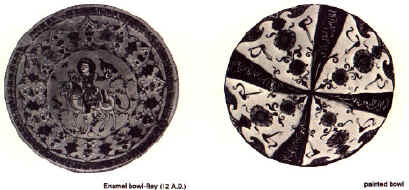
Enamel bowl- (12
A.D.) Painted bowl
The important center for
pottery in Iran during
Saljooghian era were "Rey" "Kashan"
"Neyshaboor" and "Saveh".
There are many remnants of
valuable works, which show
the creativity, taste and
initiative of unknown great
artists of Iran. After
Mongols invasion, pottery
like other artistic
activities suffered a stand
still. Historical evidence
shows that in the middle of
thirteenth century gradually
pottery workshops, started
flourishing. The most
important centers for
pottery were located in "Takhte-Soleyman"
"Soltanieh" "Tabriz" and "Varamin".
The characteristics of
ceramics in Mongols era are
painting before enameling
and also embossed designs.'
The artists of this age
created the earthen utensils
covered with turquoise
colored or orange colored
enamel. Ornamentation on
them were images of flowers,
plants, and some times
animals and birds.
In Mongols and Teimoorian
era in Iran, the art of
pottery suffered a slow
down. Few earthenware have
remained from Teimoorian's
era (15th century A.D.).
Pottery in this age could be
studied through miniature
paintings of this era images
of ceramics and tile works
are found in these
miniatures. The artists of
Teimoorian's era used green
and dark blue colors in
their works, then white and
blue ceramics were created
by
Emerging of Safavi's
dynasty (1491-1772 AD.)
after a rather inactive
period a magnificent age
started for most of the
Persian arts, as well as
pottery, which has been
improved considerably. The
methods used by potters of
this age are completely
different from their
predecessors. The artists of
Safavi's age not only
improved the art of pottery
but also brought about the
tile-works which reached its
zenith. One can see the
maturity of the art of
tile-working of Safavis
through the tile working of
Islamic construction
specially in mosques. The
cities like "Isfahan", "Yazd"
"Kerman" , "Tabriz" and "Mashhad"
became active centers of
ceramics work. The
connections of Persian
artists with Chinese artists
in Safavis dynasty brought
about valuable ceramic works
which are allocated only to
this age.
Chinese potters were
invited to come to Iran and
worked in ceramics workshops
belonging to the court of
kings of Safavis, together
with Persian artists. The
fruit of this cooperation
was different variety of
beautiful Chinaware with
Chinese techniques and
Persian ornamentation.
The valuable works of
Iranian artist potters in
Safavis era not only can be
seen in Iranian and other
museums around the worried
and private collections, but
also in tile working of
Islamic construction of that
age possessing all their own
glory and magnificence.
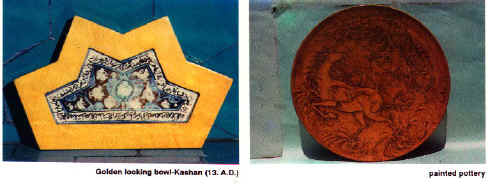
Golden looking bowl-
Kashan (13 A.D.)
Painted pottery
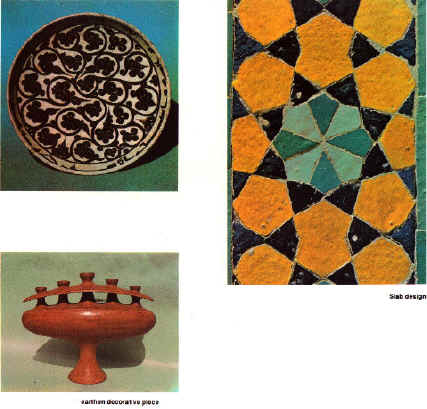
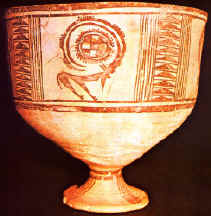
|




